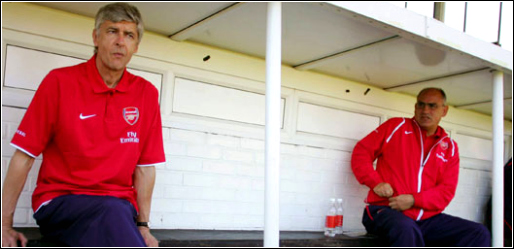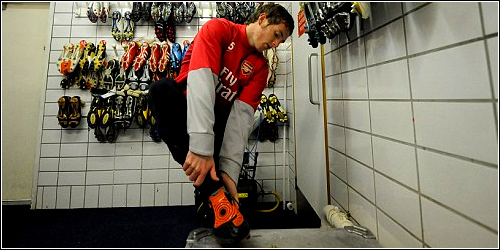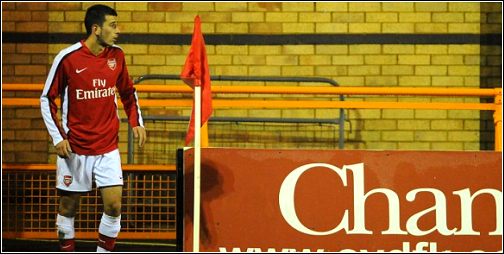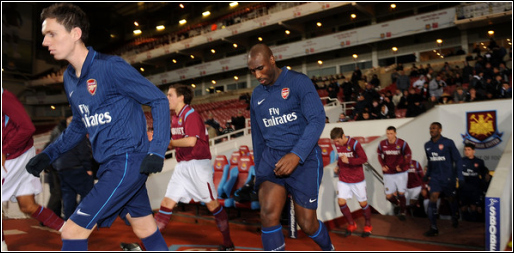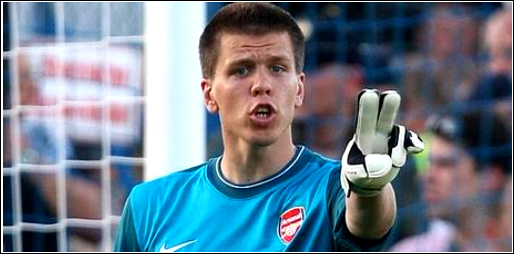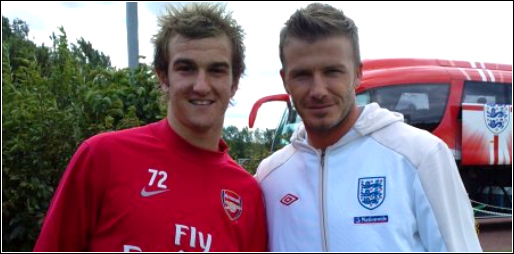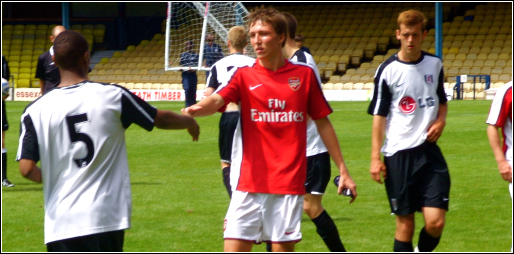
He’s regarded among Gooners worldwide as a respected commenter and his forays into the Arsenal blogging scene have been highly successful. Now, former journalist and avid fan Mike Urbanski has joined the Young Guns team to offer his analytical inside into all things Arsenal Reserves and Youth. Known among many as SKA Gooner, his Sunday column – SKA Sunday – continues today.

Normally when I settle in to watch the match or match highlights, I like to have a nicely chilled Carlsberg at my side, maybe a little Symarip playing in the background for ambiance. You know, really get the best blend of beer, music and football rolling. Unfortunately, watching the Arsenal reserves battle West Ham the other day – well, all I can say is that it’s sometimes good to be a skinhead, otherwise I’d be pulling my hair out.
I recently read an article focusing on Gael Clichy. Top bloke, he. One of the points in the article was the transition, from a defensive perspective, to the 4-3-3 formation. While it might not be immediately obvious that a defensive adjustment is needed – we’re still playing 4 at the back – the transition to attack and the two corners’ involvement and recovery to defense in that formation does require a fair bit of challenge to get used to. In the attack, Arsenal use their corners to overlap the wingers in the midfield, and where those wingers receive the ball in the 4-3-3 is often much farther up the pitch, thus requiring the corners to launch themselves into an all-out sprint to get past them and get the ball in an area where they can cross into the box. Clichy mentioned it being a hellish run just to get forward sometimes, and the difficulties that can present on recovering defensively.
I bring this up because Arsene Wenger stresses that the youth/reserve teams adopt the same formations as the senior side. The difficulty for the youth/reserve players is that they are still developing that positional discipline and learning how to read the game in a positional sense. Recognizing where to be and when, given any situation on the pitch, is one of the critical areas of development for a young player.
I think the 4-3-3 is putting extra stress on the reserve defenders. If the corners are caught out, positionally, the center backs are left holding the bag. It can be a nightmare scenario for any central defender and I noticed a good bit of this going on against West Ham. In general, if you think of the 4 defenders as an umbrella, with the two corners providing the outside cover, which is drawn farther down when on the attack, it’s a bit easier to visualize just how difficult it can be to regain defensive shape when possession is lost and the opponent moves quickly to the attack. Without a fourth midfield player who generally would hang back either as the defensive mid or holding mid in the 4-4-2, there’s extra responsibility to the corners in the 4-3-3. The central defenders, without that wide cover, are left either to shield the entire width of the pitch until backtracking help arrives or they’re susceptible to an over-the-top or horizontal pass and a great big hole exists in the center area in front of goal.
Roughly seven minutes into the second half West Ham gained possession just to their side of midfield. Sanchez Watt had just controlled and Cedric Evina had gone forward as the overlapping player. He was in the run of play. Unfortunately, Watt lost possession and West Ham immediately spotted the poor cover at the back. Francis Coquelin, at right back, was not positionally aware when possession was lost, resulting in the two center backs being hopelessly exposed. The result of the play was an over-the-top pass that caught both central defenders pinched thin in the middle, no cover from the right corner and an easy goal for West Ham on the trot.
Thus my reaction – Oi! Y’ve got a great big hole in yer defense there, son!
Here’s the jib – the run of play is forward on the left side, the left back makes his overlapping run from the midfielder – the right back must maintain an attachment to the center backs in order to provide a back line of three until the play moves farther up the pitch if control is maintained. If possession is lost, the right back must recover somewhat centrally to add to the cover should either an over-the-top or horizontal pass be forthcoming from the opponent. If the opposite corner pushes forward too far and too quickly, the center backs are left on an island with too much ground to cover. Had the play gone forward on the right side, then the left back should be the one maintaining connection to the center backs until control is realized farther up the pitch. The off man, or opposite back must maintain defensive contact. In the 4-4-2, the corners have a relief valve with the fourth midfielder and can push forward more quickly. The 4-3-3 requires a longer contact to the center backs for the off man when the run of play is opposite him. This is true regardless of what level you’re playing at – youth, reserves, first team or 5-a-side Sunday beer league.
I mentioned the Clichy article earlier to point out that even at the first team level, the defense does have responsibility to adjust with the new formation. It bears remembering that the lads in the reserve side are young and still learning, and giving up easy goals on an over-the-top ball is a lesson learned, no doubt. The harder thing to look at is the first team often make this same mistake themselves and I shake my head at the lack of positional discipline sometimes. This can be taught, and learned. Every outfield player at The Arsenal is an attacker, of sorts. Central defenders get forward at times, the corners make their overlapping runs to provide crosses into the box, the mids and forwards lead the charge. But every man has a defensive responsibility as well, and while the attacking shape has been adjusted, so too must the defense follow in order to provide proper cover.
